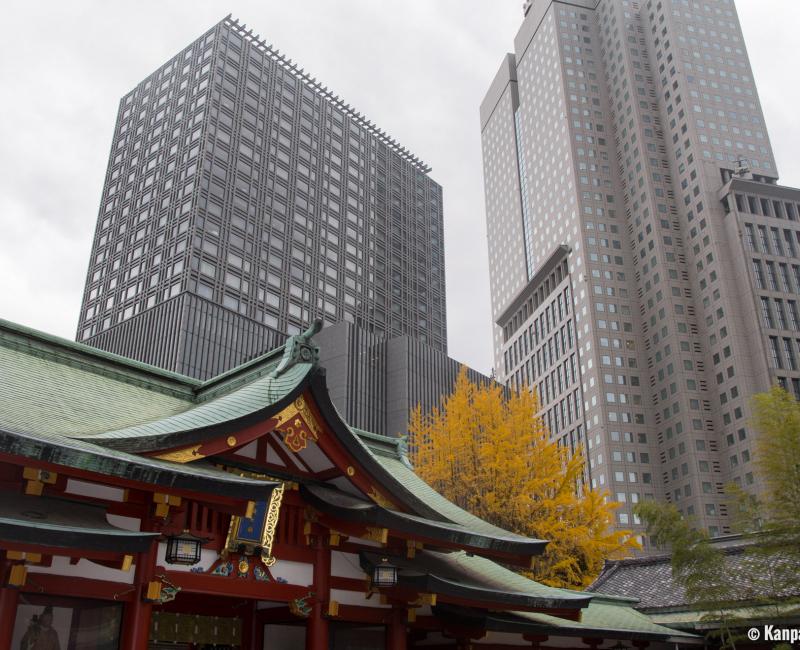Akasaka
One of the wealthiest places in central Tokyo
Akasaka is a chic district on the hills of Minato ward, in the heart of Tokyo. The gathering of business centers, residences of the imperial family and high-end shopping addresses gives a luxurious atmosphere to this area, whose generated revenues far exceed the national average. A stroll in Akasaka is an opportunity to have a taste of Japanese and foreign elites’ lives.
If you can afford it, life is pleasant in Akasaka. The area is close to the Imperial Palace and used to be a security post for Edo Castle 🏯. Since World War II, Akasaka has also been the favorite night entertainment spot for wealthy businessmen and expatriates. During the daytime, Akasaka is a peaceful, quiet and sophisticated residential area in the center of Tokyo. Like in the neighboring Roppongi, Akasaka’s landscape switches between huge companies’ skyscraper headquarters with endless glass surfaces and shopping malls so big that it is easy to get lost. This architectural entanglement does not prevent the existence of some oases of calm.

Northern Akasaka: The historical heritage
Two metro stations conveniently serve the area. On the northeastern end is Akasaka-Mitsuke Station, which gives access to the historical sites. The large Akasaka imperial estate regroups several of the imperial family’s residences, especially the residence of the Crown Prince. The Western-style front and the great iron-wrought gate of the State Guest House are reminiscent of Buckingham Palace. The place usually hosts overseas dignitaries visiting Japan. A large pedestrian way allows visitors to stand in front of the main entrance. Guided tours with prior reservation are available when the State Guest House is not being used for an official event.
There are two other places to visit, located near the limits with Chiyoda ward. The first is Hotel 🏨 New Otani's Japanese garden, open to the public during the daytime. Feel free to cross the lobby of this high-end building to reach a small traditional landscape, with its pond, waterfall and blazing red little bridge. Then, a little bit southward is Hie-jinja Shrine, one of the must-sees of the area. The shrine stands on a hill and is served by a stairway surrounded by numerous small torii ⛩️ gates. There is also a bigger entrance with an escalator on the other side of the site. Mainly frequented by the discreet neighboring inhabitants, Hie-jinja is usually pleasantly secret, except in June, during the yearly Sanno Matsuri festival.
Toyokawa Inari Betsuin, hugging the enclosure of Akasaka Palace, is also worth the visit. Mixing Buddhism and Shintoism, this place is an example of Japanese syncretism. Foreign visitors will be pleased by the countless statues of the fox god Inari and the multicolored flags hanging along the alleyways. You can also let chance guide you to discover Akasaka’s other temples and shrines during your stroll.

Southern Akasaka: Leisure activities
Around noon, a crowd of salarymen unfolds throughout Akasaka’s streets looking for small and delicious local restaurants. The offerings are indeed plethoric and cater to everyone’s means. But to find an affordable place, it is necessary to go deeper into the smallest tree-lined streets, where cars 🚙 are scarce.
The stroll continues down to the district around Akasaka Station. It is a place dedicated to shopping and leisure activities. First, visit Akasaka Sacas, a shopping mall built in 2008 around the headquarters of the Tokyoite television channel TBS. You will find shops and restaurants, and two concert and performance halls. Then, toward Roppongi at the southwestern limits of Akasaka is Tokyo Midtown, a complex of six buildings (among which is the tallest building of Tokyo) that forms a "city in the city" surrounded by the green Hinokicho Park. Tokyo Midtown houses several art galleries and contemporary art museums, like the 21_21 Design Sight, thought up and designed by Issey Miyake and Tadao Ando.
For the first time in Tokyo, there is no touristic must-see in Akasaka. The urban landscape, widely influenced by European architecture, might not be very interesting for traditional Japanese scenery amateurs. However, it is a good place to choose luxury accommodations, considering its very convenient central location and the large selection of entertainment possibilities.

